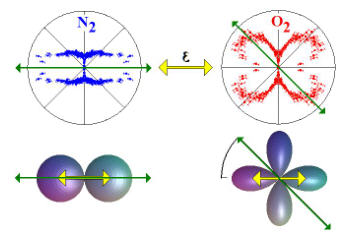Kinetic Energy Release spectra and
angular distributions
from double ionization of N2 and O2
|
If a double ionized molecule brakes symmetrical in two single charged ions we can measure the full momentum vector of both ions (classical COLTRIMS experiment) and calculate the originally orientation of the inter nuclear axis fixed in space. Together with investigations of the calculated kinetic energy release (KER) one can learn more about the occurring ionization mechanisms leading to double charged nitrogen or oxygen molecules in intense Laser fields. In case of low laser intensity (2*114 W/cm2) the first step in the multiple ionization of molecules by short intense laser pulses (10 fs) is the extraction, usually via a tunneling process, of an electron from the most loosely bound orbital in the molecule. Fig. 1. shows an outline of the ground state symmetry of N2 and O2 belonging mainly to the configurations (...πu4 3σg2 )1∑g and (…3σg2 1πu4 1πg2 ) 3∑g respectively.  Fig.1: Symmetry of outmost orbitals Our experiments shows that N2 molecules are likely to get double ionized if their inter nuclear axis is aligned along the linear polarization vector (epsilon) while the double ionization rate of O2 molecules tend to maximize at around 40 degrees.  Fig. 2: Polar plots of angular distributions of N+/N+ and O+/O+ as a function of theta. The green arrow represents the orientation of the inter nuclear axis for the double ionization maximum. We interpret this to be due to the angular distribution P1(q) of the first step of the rescattering ionization process. Molecular ADK tunneling calculations (Tong et al.) predict that this angular distribution should reflect the symmetry of the most loosely bound orbital of the molecule, which for oxygen is a pg while for the nitrogen it is a sg. For high laser peak intensities and longer pulses, other ionization processes come along and the distributions increasingly fold toward the polarization vector, ultimately peaking at zero degrees for both molecules. Kinetic Energy Release (KER) spectra of measurements within the rescattering regime show that the process proceeds through well defined electronic states of the excited molecular dications. They appear as distinct lines which correspond to discrete kinetic energy releases in the doubly charged precursor molecule. A three-dimensional momentum analysis is necessary to see this structure. If only the z-momentum spectrum is measured, as would be the case if only the times-of-flight were measured, this fine structure would be entirely washed out by the angular distribution of the fragments.  Fig.3: KER distributions for N+/N+ and O+/O+ within the rescattering regime. The peak identifications are labeled by letters corresponding to the states listed in table 1. These spectra are very similar to the KER spectra seen when these molecules are dissociated by fast (200 eV) electron bombardment. Extremely high resolution Doppler-free measurements (Lindqvist et al.), combined with extensive theoretical calculations allowed those authors to make unambiguous identifications of the states involved. A comparison of their KER spectra with ours reveals that the same states are being populated in the laser experiment, even with similar relative intensities.  Table 1. Electronic states of the dications whose decay we observe. Configurations are indicated relative to the ground state configuration of the neutral molecule. Details can be found in Diplomarbeit Stefan Voss. Collaboration with http://www.phys.ksu.edu/area/jrm/ Prof. C. Lewis Cocke
Further information: |